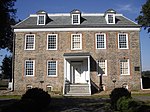Historic House Trust
The Historic House Trust of New York City was formed in 1989 as a public-private partnership with the New York City Department of Parks and Recreation[1] to preserve the historic houses located within New York City parks,[2] although most of the houses were not originally city-owned.[3] The Trust works with the individual houses to restore and promote the houses as a means of educating residents and visitors about the social, economic and political history of New York City and cast urban history in a new light.[4] The Trust includes 23 historic sites, with 18 operating as museums and attracting 729,000 annual visitors.[2]
Properties
[edit]The Historic House Trust includes properties in each of New York City's five boroughs,[5] and there is a house for every period in the City's history, depending on one's scheme of dividing history.[4] A number of the properties have live-in caretakers to help prevent vandalism and other problems.[6]
History
[edit]In 1988, the City Parks department established a Historic House Office to preserve the 23 City-owned historic house-museums located in City parks. This office gave way to the Historic House Trust of New York City in 1989, funded by private donations,[9] as well as grants,[10] with the goal of each house becoming a professionally accredited museum.[11] In an effort to increase awareness of the program during its first year of operation, the Trust developed a so-called passport program wherein visitors would receive stamps each time they visited one of the houses. If a visitor went to all 23 properties, they would receive an audience with the Mayor.[12] HHT's passport program was brought back in 2008 as a method of commemorating the Trust's 20th anniversary.[13]
The Trust also holds events such as the Historic Houses Festival, during which all the houses are open with different events at each, in order to raise awareness.[9] New properties are added to the Trust when they come under city control if private care-taking or ownership has not succeeded,[14] although the contents of the home may remain under private ownership.[15]
References
[edit]- ^ Albanese, Laura (2007-03-26). "Restoration bringing Lott all back home". New York Daily News. Archived from the original on 2011-06-05. Retrieved 2008-08-13.
- ^ a b "About Us". The Historic House Trust of New York City. Archived from the original on 2008-02-16. Retrieved 2008-03-15.
- ^ "Polishing the City's Gems". The New York Times. 1989-06-23. Retrieved 2008-03-15.
- ^ a b Amy Gale (2004-09-08). "Houses Bring New York's Past to Life". The Christian Science Monitor. Retrieved 2008-03-15.
- ^ "Houses". The Historic House Trust of New York City. Archived from the original on 2008-03-16. Retrieved 2008-03-15.
- ^ Lynn M. Ermann (1999-05-23). "Making it Work; A Life of Housework". The New York Times. Retrieved 2008-03-15.
- ^ Richard Weir (1999-01-17). "Old Tree May be Benched". The New York Times. Retrieved 2008-03-15.
- ^ Richard Weir (1999-03-14). "Weeping Beech Will Live On in Memory, and in Art". The New York Times. Retrieved 2008-03-15.
- ^ a b "15 Historic Houses Saved from Obscurity". The New York Times. 1989-05-11. Retrieved 2008-03-15.
- ^ Richard Weir (1998-06-28). "Marine Park; A Farmhouse with a Future". The New York Times. Retrieved 2008-03-15.
- ^ Timothy C. Forbes, Betsy Gotbaum (1991-11-10). "Old Yacht Club". The New York Times. Retrieved 2008-03-15.
- ^ Carol Vogel (1989-06-22). "Currents; A Passport to History in Houses". The New York Times. Retrieved 2008-03-15.
- ^ "20th Anniversary". Historic House Trust. Archived from the original on 2011-07-26. Retrieved 2008-08-13.
- ^ Richard Weir (1999-02-28). "Fort Totten's Old Houses are Tottering". The New York Times. Retrieved 2008-03-15.
- ^ Jim O'Grady (2003-06-22). "Fresh Hope for a Modest House That Helped Nurture Freedom". The New York Times. Retrieved 2008-03-15.






















